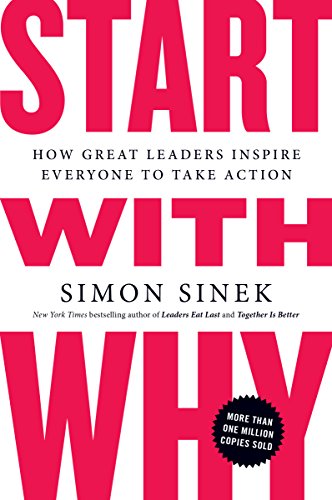

This article is an excerpt from the Shortform summary of "Start With Why" by Simon Sinek. Shortform has the world's best summaries of books you should be reading.
Like this article? Sign up for a free trial here .
Motivation is a well-acknowledged aspect of good management. What are Simon Sinek’s views on motivation? Does he have any thoughts on how to increase motivation in employees and inspire a team?
We’ll cover Simon Sinek’s thoughts on motivation, from his book Start with Why. Then we’ll look at how success can actually be detrimental to an organization’s motivation, and how to keep motivation alive and your company on track.
Simon Sinek on Motivation & Inspiration
Those who lead aren’t necessarily #1 terms of market share, but they’re the companies or people who are setting the course for their industries. Apple computers only make up 3 percent of the global home computing market share; however, Apple leads the technology industry because of its impact and vision. Other technology companies are trying to become Apple, not the other way around. Simon Sinek believes motivation is the key to changing the industry.
Great leaders:
- Create a following of loyal people who rally around their WHY.
- Inspire people to act because they want to, not because they’re responding to an outside incentive.
- Belong to all different sectors and aren’t just business tycoons or politicians. Great leaders can come from any walk of life or industry.
- Have exceptional amounts of influence inside and outside of their industries.
Simon Sinek: Motivation & Its Value
Studies show that most people are disengaged from their job. They lack a sense of purpose. And this feeling often starts from the top. Simon Sinek believes motivation is lacking because there’s no WHY. Instead, if every leader started with WHY, great results might happen:
- People would love their jobs. Right now, 80 percent of Americans say they don’t have their “dream job.” By embracing WHY, organizations create inspirational environments—which in turn lead to happy workers.
- People would be more productive. People with their dream jobs love going to work in the morning—which leads to more creativity, productiveness, and
- People would just be happier. When you’re more fulfilled at work, you bring that joy home with you, too.
- Companies and economies would grow stronger. They would operate on trust, not fear, which would lead to growth.
Simon Sinek on Success & Decreased Motivation
So far, the book has covered how to take a company or organization without a clear WHY and put it on the right track. But what happens when a company has a WHY—but has lost it along the way? Simon Sinek believes motivation can falter when a company becomes successful.
How Success Can Negatively Affect Your Motivation
Top executives and business owners have a common problem. When they were asked whether they felt successful, 80 percent of attendees said no. They all felt that as they became successful, they lost the thing that made their business special. Simon Sinek believes motivation was lost.
The pattern: although these leaders knew WHAT they did and HOW they did it, they’d become disconnected from their WHY.
The biggest hurdle any company will face is success. That definitely sounds counterintuitive, doesn’t it? After all, isn’t success the goal behind starting with WHY?
The problem is that as a company grows, leadership becomes more removed from the company’s messaging. In terms of the Golden Circle, when your company grows, the rings of the Golden Circle get wider, which moves the leader with the passionate vision further away from making every decision for the company. Simon Sinek thinks motivation decreases when you lose touch with your WHY.
When that happens, it’s easy to shift focus from WHY to WHAT—and before you know it, WHY starts coming last. Sink refers to this as “the split,” which he says happens to many successful companies.
That’s why success–or at least, success that makes you lose sight of your WHY–can have negative ramifications on even the most successful company, like:
- Having your WHY’s clarity become cloudy–or worse, non-existent
- Losing your motivation/inspiration
- Employees feeling like work is “just a job,” not a mission.
Think of it this way: the growth of a company is usually measured by your WHAT. As your WHAT increases, your company grows. That makes your “megaphone” louder—but without sticking with your WHY, your message gets muddy.
Eventually, your communication with your customers isn’t inspirational. It’s just noise. Simon Sinek says when motivation lags, success does, too.
Case Study from Simon Sinek: Motivation and the Problem With Walmart
When Sam Walton founded Walmart in 1962, he had one core belief: if he looked after people, then people would look after him and his company. Sam Walton believed in the power of community. That philosophy is what led Walmart from its humble beginnings as a mom-and-pop shop in Arkansas to become the biggest retailer in the world.
As the company grew, Sam Walton stayed committed to his WHY. But when he died, the Walmart became disconnected from its WHY. Instead, executives began to focus on HOW the company did business: selling products at low prices. Simon Sinek thinks motivation was lacking due to a loss of WHY.
In the process, it sacrificed how it treated people. As a result, Walmart has faced scandal after scandal over treating employees poorly, and it owes hundreds of millions of dollars in settlements.
Competition and changing economy isn’t what’s hurting Walmart: Walmart has become its own worst enemy because it’s success has disconnected it from its WHY. Simon Sinek believes motivation loss is a factor.
The School Bus Test
To counter the problem of losing your WHY, use the School Bus Test is simple: if your CEO was hit by a school bus tomorrow, would the organization continue to thrive? Would the motivation be alive?
- If yes, that means the founder’s WHY has been embraced by the company from the top down. Even without the CEO, the mission remains clear.
- If not, that means your WHY is too dependent on the CEO’s presence. Without a clear legacy of WHY, the organization will eventually split into WHAT, which will erode the company’s competitive edge.
Strong, inspirational leaders like Steve Jobs, Bill Gates, and Sam Walton do more than just share their company’s values: they embody them and maintain discipline throughout the organization. So when those leaders are gone, the company runs the risk of moving into the split. In other words, a change in leadership is a good time for the company to lose sight of its WHY. Simon Sinek believes motivation can decrease during these transitions.
Unfortunately, this is a common issue. Here are three examples of companies that haven’t planned for succession, and as a result, have gone through the split:
- Walmart: After founder Sam Walton died, the company stopped working on being a part of the community and instead focused on selling goods at low prices.
- Microsoft: When co-founder Bill Gates stepped down, Microsoft stopped being a company out to change the world, and instead became a software company.
- Starbucks: With the exit of founder Howard Shultz, Starbucks stopped being the “third space” for people to meet and exchange ideas. It became a premium coffee shop instead.
Plan Smooth Successions
Since the WHY usually comes from the company’s founder, it’s important to plan for a smooth succession that keeps your WHY intact when he or she eventually leaves.
In order to make the transition successful, the original founder needs to make their WHY as clear as possible. They have to leave a clear cause/belief for their successor to champion. Without that, the next leader is more likely to focus on the company’s WHAT.
Successors to influential leaders need to be picked based on their belief in the company’s WHY, not necessarily their skills or current position. If the new leader can’t communicate the company’s vision and values clearly, then the employees in the organization won’t be able to, either. Simon Sinek believes motivation is the key to a successful business, but a successful business can ruin motivation.
———End of Preview———

Like what you just read? Read the rest of the world's best summary of "Start With Why" at Shortform . Learn the book's critical concepts in 20 minutes or less .
Here's what you'll find in our full Start With Why summary :
- What Steve Jobs did right compared to every other business leader
- How to define your organization's WHY
- How to help your organization avoid losing its edge as it succeeds







That was a concise summary thank you for saving my time from reading the whole book